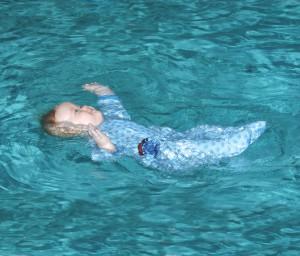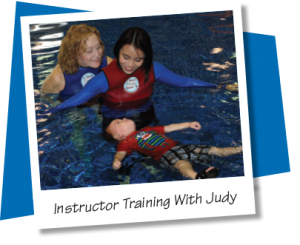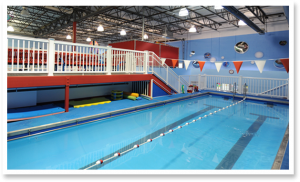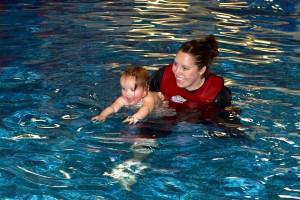Beautiful Wednesday everybody! Today we have Judy Heumann, founder of Infant Aquatics℠ and owner of Swim Float Swim! Aquatic Academy
 Judy began teaching little ones to swim in 1974 in Texas. In the early 1980’s, as a swim instructor and a mom with two babies, she was acutely aware of the danger her backyard pool posed to her children. And so she began developing techniques to allow them how to safely enjoy the water. Over the years she became friends with other members of the survival swim community and launched the infantaquatics.com website in 2000. Her goal was to educate parents on the lifesaving aquatic skills that infants can be taught and to help them find certified instructors to teach their children these skills.
Judy began teaching little ones to swim in 1974 in Texas. In the early 1980’s, as a swim instructor and a mom with two babies, she was acutely aware of the danger her backyard pool posed to her children. And so she began developing techniques to allow them how to safely enjoy the water. Over the years she became friends with other members of the survival swim community and launched the infantaquatics.com website in 2000. Her goal was to educate parents on the lifesaving aquatic skills that infants can be taught and to help them find certified instructors to teach their children these skills.
“In order to describe what infant swimming is, it’s important to understand what infant swimming isn’t. Infant  swimming isn’t just playing “humpty dumpty” in the pool with your baby. It’s not just about being comfortable in the water, it’s being able to swim and survive. It’s giving babies the ability to save THEMSELVES should they happen to reach the water alone. The ability of a baby to float and breathe, regardless of the water’s depth, for an indefinite period of time is an accurate description of infant swimming.”
swimming isn’t just playing “humpty dumpty” in the pool with your baby. It’s not just about being comfortable in the water, it’s being able to swim and survive. It’s giving babies the ability to save THEMSELVES should they happen to reach the water alone. The ability of a baby to float and breathe, regardless of the water’s depth, for an indefinite period of time is an accurate description of infant swimming.”
So what is the purpose and advantage of baby swimming classes? According to the National Safe Kids Campaign, drowning is the second leading cause of unintentional injury-related death to children ages 1-5. The purpose of Infant Aquatics℠ lessons is to give babies a fighting chance at survival by providing them with the ability to handle an accidental encounter with the water. Judy and her team do this by teaching infants as young as 6 months the lifesaving skill of rolling from face down in the water to a stable back float so that they can breathe until they are rescued. Toddlers who are walking learn a more advanced skill set which includes propelling on their tummies, rolling onto their backs to breathe, and then flipping back onto their tummies to swim again: Swim•Float•Swim!
The benefits of enrolling babies in survival focused lessons are numerous. In addition to providing water safety skills, research has shown that there are many more reasons to teach babies to swim. Scientific studies of infant swimming have shown that the early stimulation which swimming provides helps to develop the child in three key areas: Physically, Mentally, and Emotionally. As compared with a control group who did not take year-round lessons, the children who swam consistently from infancy were found to be significantly stronger and more coordinated. Muscles developed in a process similar to physical therapy, enabled the children to excel at all physical activities, which was not limited to swimming. Emotionally, children who swam year-round were found to be more self-disciplined, motivated, and self-confident due to the constant goal setting, learning, and achievement, that goes on during lessons. Judy has seen that starting lessons at a young age leads to increased self-esteem in her students, gives parents peace of mind when they are around water with their children, and fosters a better quality of family life.
 Judy’s greatest achievement as an instructor/swimmer is personally teaching over 7,000 children lifesaving aquatic skills, knowing that her lessons have saved countless lives, and training over 50 dedicated instructors who are expanding her mission of child drowning prevention on 5 continents through the Infant Aquatics℠ Network of certified instructors.
Judy’s greatest achievement as an instructor/swimmer is personally teaching over 7,000 children lifesaving aquatic skills, knowing that her lessons have saved countless lives, and training over 50 dedicated instructors who are expanding her mission of child drowning prevention on 5 continents through the Infant Aquatics℠ Network of certified instructors.
For Judy, one of the biggest mistake parents make is assuming that flotation devices will keep children safe around water and help them learn to swim. The opposite is true for a lot of reasons which Judy explained to us:
- They give children and parents a false sense of confidence. Parents use them to avoid getting in the pool with their kids. When kids are wearing water wings and are in a pool without you, they think they can swim and they can’t. This has led to many drownings, both fatal and non-fatal, because when these children enter the water without them, they assume a vertical posture and sink.
- Flotation devices make it harder to teach a child to swim. Water wings force the child into a vertical posture, with head up and feet pedaling underneath. Because babies’ heads are the heaviest part of their bodies, they cannot raise their head to breathe, and must learn to swim and float horizontally, with face in the water and feet at the surface.
Another mistake she mentioned is underestimating your baby’s ability to learn. Don’t assume that because your baby can’t talk, he is incapable of learning to swim, nor that if a toddler is fussing, they won’t be successful. Crying means your baby is breathing. It is also a baby’s way of communicating to summon help and that’s a good thing when you’re dealing with preventing drowning. Infant Aquatics℠ believes that each and every baby has the ability to rescue himself- they just need to unlock that ability. Once this happens, babies learn to discover the joy in swimming.
And finally, Judy pointed out that parents should not let all of the hype about “dry drowning” that they read on the Internet be an excuse for not arming their children with the ability to save themselves in the water. Incidents of drownings in children associated with swim lessons are almost unheard of. Drowning can happen at any age. There are no second chances. That is why it is important to put your baby in the hands of a skilled instructor who knows how to establish breath control from the very first lesson.
Judy’s goal for the coming year is to train veteran instructors to certify new Infant Aquatic Survival℠ specialists so that their lessons are more readily available to families across the U.S. and around the world so that more little lives can be saved.
 Judy shares her best tip for parents who are considering enrolling their babies in swim lessons:
Judy shares her best tip for parents who are considering enrolling their babies in swim lessons:
"If you are considering enrolling your baby in our swim school or any other school, the most important tip I can give is to do your homework. Go to the pool, observe lessons, and speak with parents whose children are in the program. Stay as long as possible. Ask questions. Notice the skills that are being taught. Ask how long it will take for your baby to learn to master survival skills and for your toddler to be able to swim and float independently. It should not take months or years to teach a child to safely swim. If you want to learn more about our school specifically, explore our website. Watch the videos featuring our parents and our staff."
The Swim Float Swim! facility is designed to enhance children’s learning, safety, and comfort. They have a 90-degree round teaching pool and a warm water lap pool for teaching stroke technique. Ultraviolet purification kills bacteria and lowers chlorine without chemicals.
 All initial lessons are private, one-on- one, scheduled 4 days per week. With their unique method, child-focused facility and nurturing staff, you’ll see incredible results in weeks, not years. A complete course of private lessons typically requires 4 weeks for infants, 6 weeks for children 1 to 3 years and 3 weeks for children 4 years and up. Judy explained that once children acquire survival skills, instructors test them in clothes to better prepare them for unexpected falls into the water. During the final week, parents learn how to swim with their children and how to help them maintain their skills.
All initial lessons are private, one-on- one, scheduled 4 days per week. With their unique method, child-focused facility and nurturing staff, you’ll see incredible results in weeks, not years. A complete course of private lessons typically requires 4 weeks for infants, 6 weeks for children 1 to 3 years and 3 weeks for children 4 years and up. Judy explained that once children acquire survival skills, instructors test them in clothes to better prepare them for unexpected falls into the water. During the final week, parents learn how to swim with their children and how to help them maintain their skills.
The question that we all probably very curious about is, will babies retain their skills?
Judy says experience has shown that babies will retain most of what they learn after being out of the water for up to a year. However, they will likely lose their self-confidence if they are out of the water for even a short time. For this reason, Judy encourages parents to continue their baby’s progress in a weekly group class. Judy offers Aquababies classes for babies under 23 months and their parents and FunDay groups for preschoolers between 2-4 years.
For more information on how to find an Infant Aquatics℠ instructor or information on becoming an instructor www.infantaquatics.com (for a directory of instructors and locations) and visit www.infantaquaticsurvival.com to learn about an exciting career as an Infant Aquatic Survival℠ Specialist.
For more information about Judy Heumann and Swim•Float•Swim! please visit their website at www.swimfloatswim.com or email at [email protected]uatics.com



